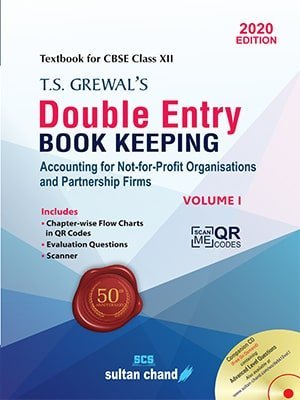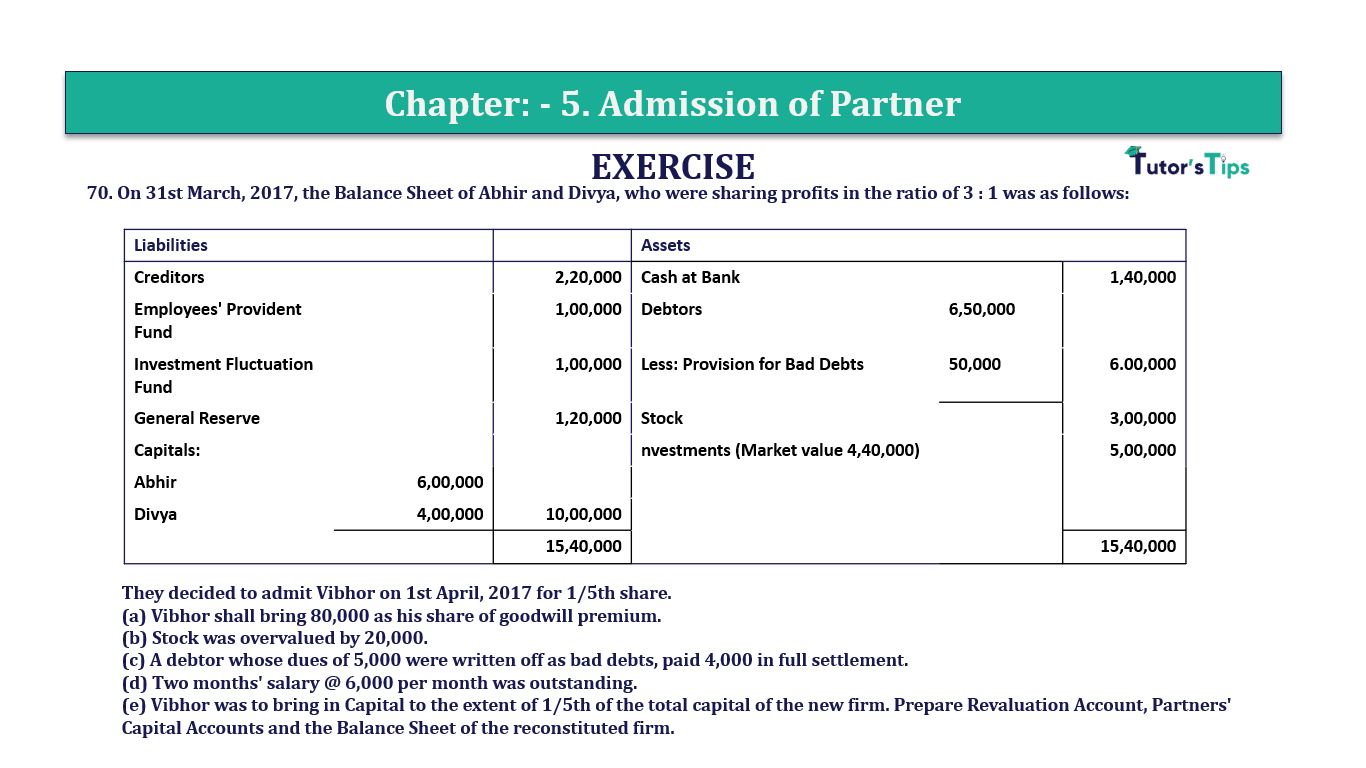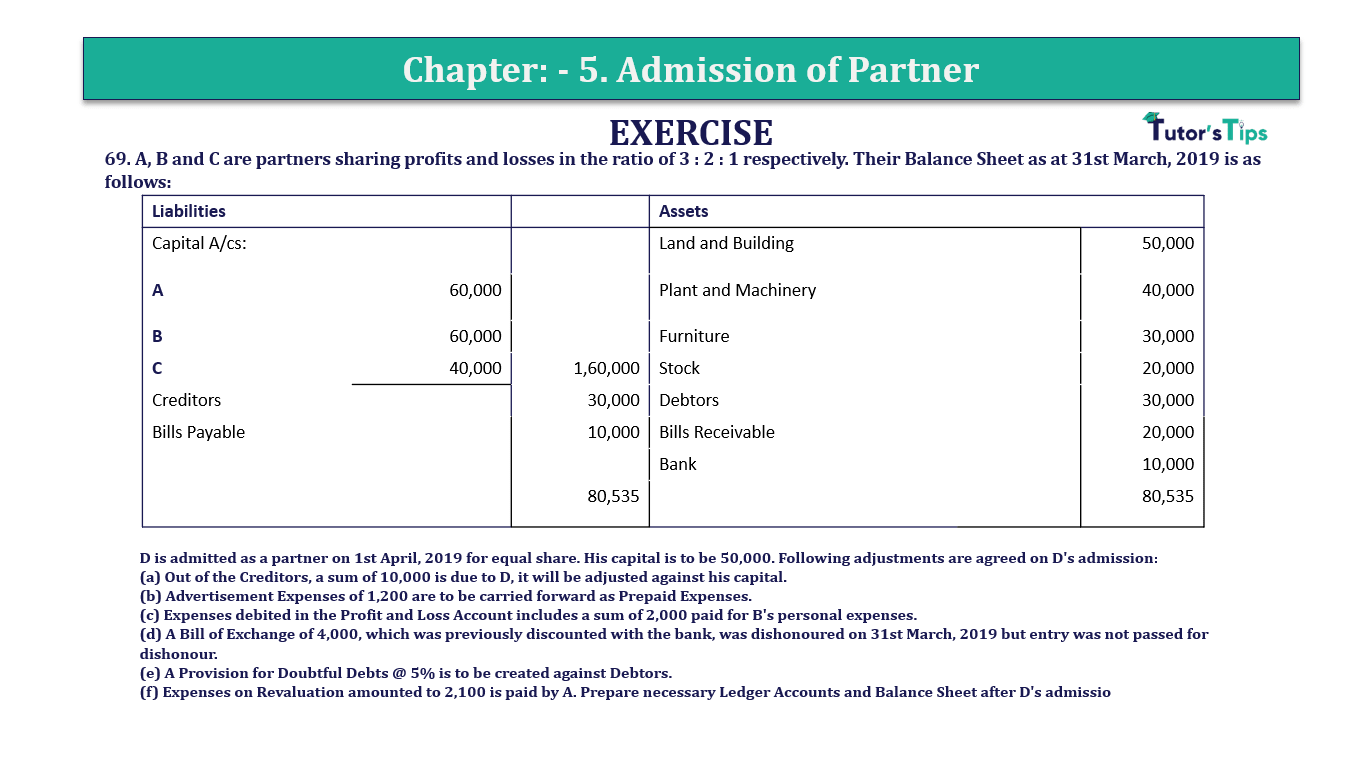Question 70 Chapter 5 of +2-A
70. On 31st March, 2017, the Balance Sheet of Abhir and Divya, who were sharing profits in the ratio of 3 : 1 was as follows:
| Liabilities | Assets | ||||
| Creditors | 2,20,000 | Cash at Bank | 1,40,000 | ||
| Employees’ Provident Fund | 1,00,000 | Debtors | 6,50,000 | ||
| Investment Fluctuation Fund | 1,00,000 | Less: Provision for Bad Debts | 50,000 | 6.00,000 | |
| General Reserve | 1,20,000 | Stock | 3,00,000 | ||
| Capitals: | nvestments (Market value 4,40,000) | 5,00,000 | |||
| Abhir | 6,00,000 | ||||
| Divya | 4,00,000 | 10,00,000 | |||
| 15,40,000 | 15,40,000 |
They decided to admit Vibhor on 1st April, 2017 for 1/5th share.
(a) Vibhor shall bring 80,000 as his share of goodwill premium.
(b) Stock was overvalued by 20,000.
(c) A debtor whose dues of 5,000 were written off as bad debts, paid 4,000 in full settlement.
(d) Two months’ salary @ 6,000 per month was outstanding.
(e) Vibhor was to bring in Capital to the extent of 1/5th of the total capital of the new firm. Prepare Revaluation Account, Partners’ Capital Accounts and the Balance Sheet of the reconstituted firm.
The solution of Question 70 Chapter 5 of +2-A: –
| Revaluation Account |
|||||
| Liabilities |
Amount | Assets | Amount | ||
| To Stock A/c | 20,000 | By Cash A/c | 4,000 | ||
| To Outstanding Salary A/c (6,000 × 2) | 12,000 | ||||
| Loss transferred to | |||||
| Abhir’s Capital A/c | 21,000 | ||||
| Divya’s Capital A/c | 7,000 | 28,000 | |||
| 32,000 | 32,000 | ||||
| Partners’ Capital Account the year ended 31st March, 2019 |
|||||||
| Parti culars |
Abh |
Div ya |
Vib hor |
Partic |
Abh ir |
Div ya |
Vib hor |
| To Revaluation A/c (Loss) | 21,000 | 7,000 | – | By Balance B/d | 6,00,000 | 4,00,000 | – |
| By Cash A/c | – | – | 3,03,000 | ||||
| By Premium for GoodwillA/c | 60,000 | 20,000 | – | ||||
| By Investment Fluctuation 30,000 10,000 Fund A/c (1,00,000 – 40,000 | 30,000 | 30,000 | – | ||||
|
By General Reserve A/c |
90,000 | 30,000 | |||||
| To Balance c/d | 7,59,000 |
4,53,000 | 3,03,000 | ||||
| 7,80,000 | 4,60,000 | 3,03,000 | 7,80,000 | 4,60,000 | 3,03,000 | ||
| Balance Sheet |
|||||
| Liabilities |
Amount | Assets | Amount | ||
| Employee’s Provident Fund | 1,00,000 | Cash at Bank | (1,40,000 + 4,000 + 3,03,000 + 80,000) | 5,27,000 | |
| Creditors | 2,20,000 | Debtors | 6,50,000 | ||
| Outstanding Salary | 12,000 | Less: Provision for Doubtful Debt | 50,000 | 6,00,000 | |
| Capital: | Stock | 2,80,000 | |||
| Abhir | 7,59,000 | Investments | 4,40,000 | ||
| Divya | 4,53,000 | ||||
| Vibhor | 3,03,000 | 15,15,000 | |||
| 18,47,000 | 18,47,000 | ||||
Working Note:-
Calculation of New profit-sharing ratio
Advertisement-X
| Remaining share | = | 1 | – | 1 |
| 5 |
| = | 5 – 1 | |
| 5 |
| = | 4 | |
| 5 |
To Calculate to New Ratio distribute the remaining share in the old ratio of old partners’
New Ratio = Combined share of A and B X Old Ratio
| Abhir’s New Share of Profits | = | 3 | X | 4 |
| 5 | 5 |
| = | 12 | |
| 25 |
| Divya’s Sacrificing Ratio | = | 2 | X | 4 |
| 5 | 5 |
| = | 8 | |
| 25 |
| Vibhor’s New Ratio | = | 1 | X | 5 |
| 5 | 5 |
| = | 5 | |
| 25 |
New Profit sharing Ratio between Abhir : Divya : Vibhor = 12 : 8 : 5
Calculation of Vibhor’s Capital
| Total Adjusted Capital of the Old Partners | = | Abhir’s Capital + Divya’s Capita |
| Total Adjusted Capital of the Old Partners | = | (7,59,000 + 4,53,000) |
| = | 12,12,000 |
Advertisement-Y
| Combined New Share of the Old Partner | = | 12 | + | 8 |
| 25 | 25 |
| = | 20 | |
| 25 |
| Total Capital of the firm | = | (Adjusted Capital of the Old Partners × Reciprocal of Combined New Share of the Old Partners) |
| = | (12,12,000 × 25/20) | |
| = | 15,15,000 | |
| Vibhor’s Capital | = | Total Capital of the firm × His Profit share |
| = | (15,15,000 × 1/5) | |
| = | 3,03,000 |
T.S. Grewal’s Double Entry Book Keeping +2 (Vol. I: Accounting for Not-for-Profit Organizations and Partnership Firms)
- Chapter No. 1 – Financial Statement of Not-For-Profit Organisations
- Chapter No. 2 – Accounting for Partnership Firms – Fundamentals
- Chapter No. 3 – Goodwill: Nature and Valuation
- Chapter No. 4 – Change in Profit-Sharing Ratio Among the Existing Partners
- Chapter No. 5 – Admission of a Partner
- Chapter No. 6 – Retirement/Death of a Partner
- Chapter No. 7 – Dissolution of a Partnership Firm
T.S. Grewal’s Double Entry Book Keeping (Vol. II: Accounting for Companies)
- Chapter No. 8 – Company Accounts – Accounting for Share Capital
- Chapter No. 9 – Company Accounts – Issue of Debentures
- Chapter No. 10 – Redemption of Debentures
T.S. Grewal’s Double Entry Book Keeping (Vol. II: Accounting for Companies)
- Chapter No. 1 – Financial Statements of a Company
- Chapter No. 2 – Financial Statement Analysis
- Chapter No. 3 – Tools of Financial Statement Analysis – Comparative Statements and Common- Size Statements
- Chapter No. 4 – Accounting Ratios
- Chapter No. 5 – Cash Flow Statement
Advertisement-X
Check out T.S. Grewal +2 Book 2020@ Official Website of Sultan Chand Publication








Leave a Reply